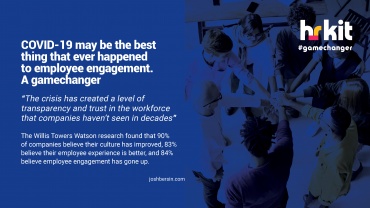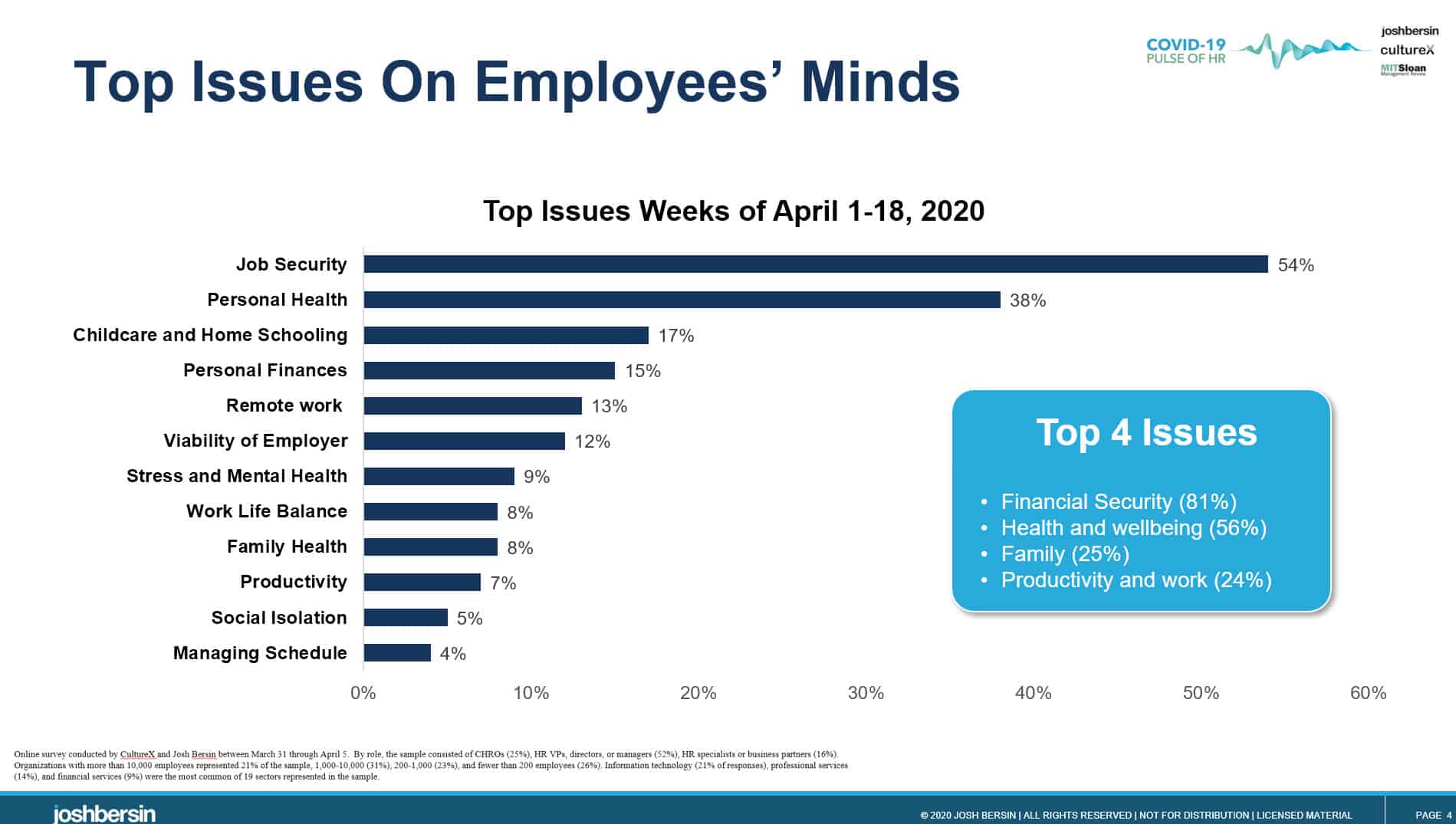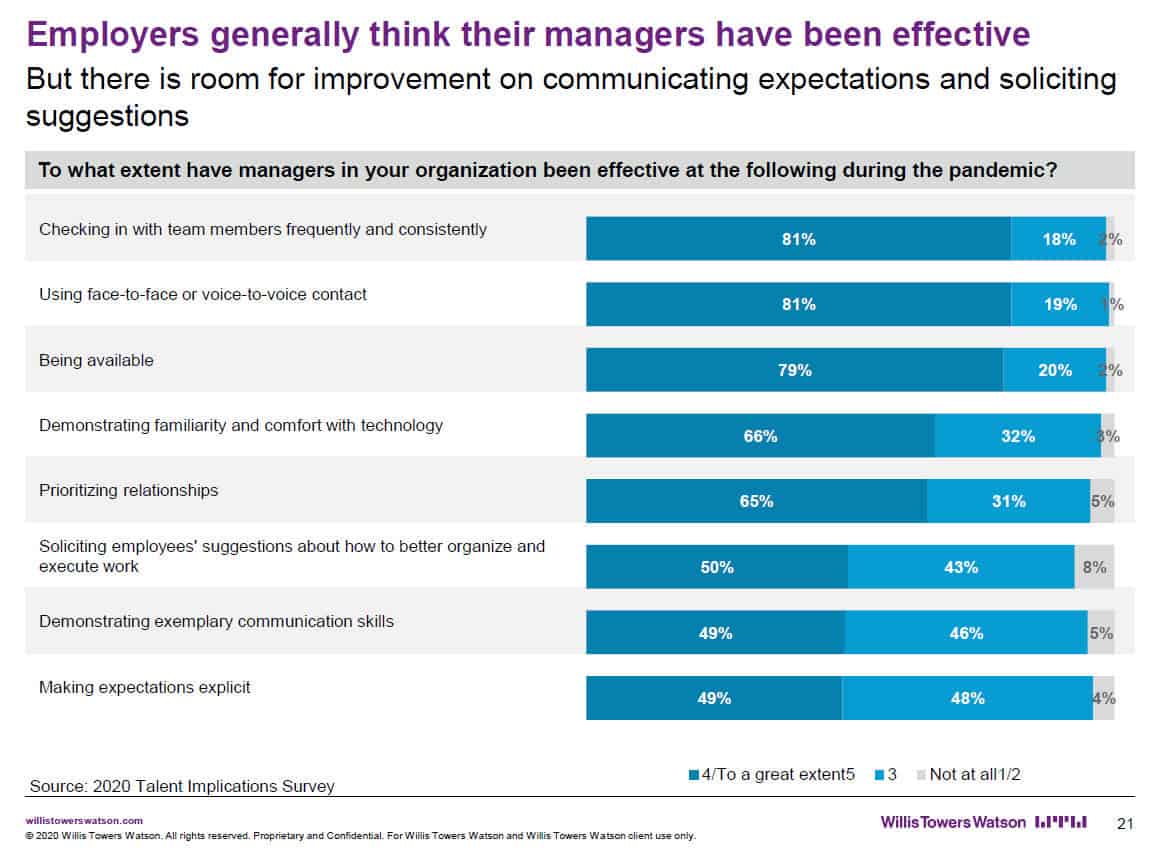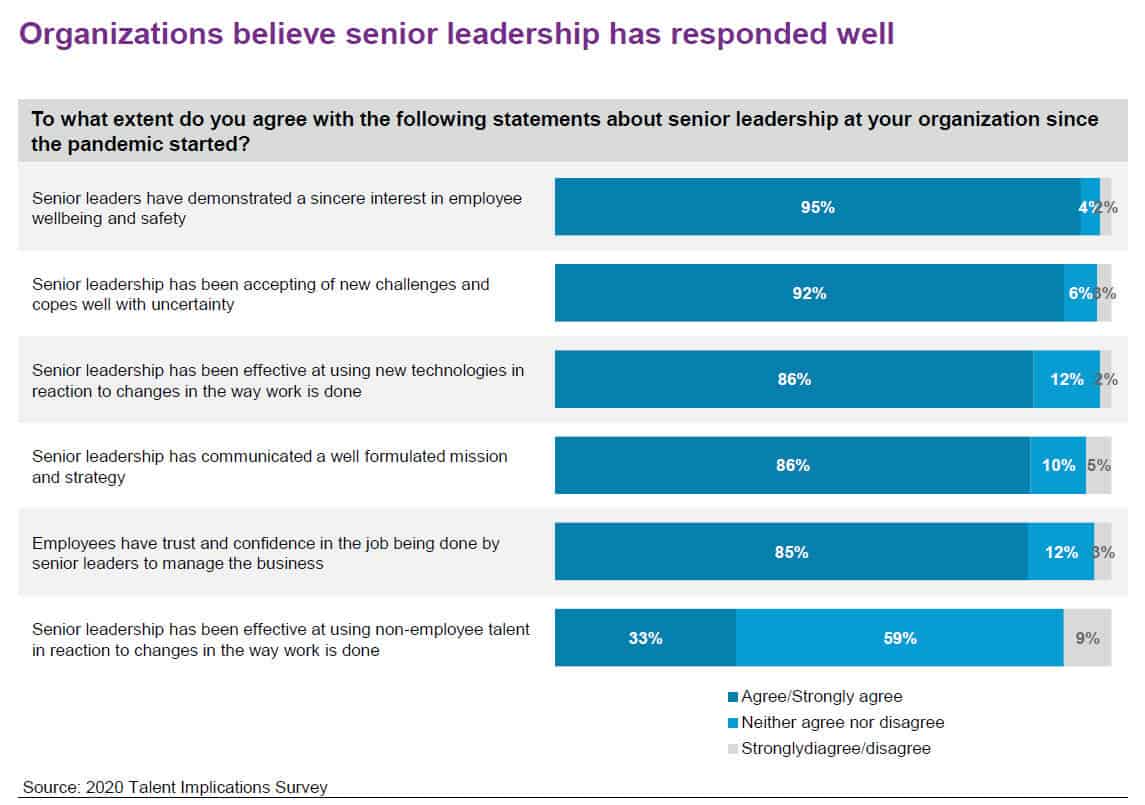COVID-19 May Be The Best Thing That Ever Happened To Employee Engagement
The Coronavirus is accelerating one of the biggest business transformations in decades. Yes, it’s a health crisis but for most companies, it’s also an incredible opportunity to transform.
Consider a bizarre thought. In the middle of a pandemic, our research now shows that companies are treating their employees better than ever. And employee engagement, a problem that plagues more than two-thirds of companies year after year, is actually going up.
Let me explain.
I’ve been on the phone with more than 30 companies this week, and we are now doing a bi-weekly pulse of HR organizations. This data, coupled with a new study just completed by Willis Towers Watson, shows clearly that businesses are bending over backward to take care of their employees.
Why? Because they have to.
Yesterday I talked with the CHRO of one of the world’s largest insurance companies and she told me “the crisis has created a level of transparency and trust in our workforce we haven’t seen in decades.” The Willis research found that 90% of companies believe their culture has improved, 83% believe their employee experience is better, and 84% believe employee engagement has gone up.
It took a global health crisis for business and HR leaders to wake up to the fact that when people don’t feel safe, supported, or emotionally secure, they simply cannot do their jobs. So now we see that this is a business transformation disguised as a pandemic.
Let me dig in just a little bit here, and give you the data.
1/ First, companies are protecting workers. It’s clear from our data that the #1 thing on the minds of most employees today is personal financial security. Yes, they’re worried about their health, but above that they’re worried about their jobs, the viability of the company, and their ability to take care of their children, families, and parents. And for Millennials and younger workers, they are now worried about their careers.
How are companies addressing this? They’re giving employees more flexible benefits, they’re improving work at home programs, they’re giving them free wellness and other forms of education, they’re encouraging people to take a paid vacation, and they’re even helping furloughed people find new positions. Two tech firms I talked with told me they are helping employees with loans and financial counseling, and the People+Work Connect consortium is flooded with applications.
While there are furloughs and layoffs in many industries, the overall focus on pay is positive. The Willis Towers Watson study found that only 15% are cutting pay and only 17% are reducing or delaying merit increases.
2/ Second, is a huge increased focus on personal productivity, wellbeing, and personal resilience. As more than 90% of companies started their work at home program, the first issue they deal with is getting computers, internet access, security, and tools into people’s homes. And this wasn’t easy.
In India, for example, people live in very small spaces so companies had to buy equipment, ship it, and work through government providers to get it into peoples’ homes. And since internet is spotty, companies like ServiceNow gave employees generous allowances for Mi-Fi devices and just said “go out and buy what you need, don’t worry about the expense forms.”
Once people started working at home, companies immediately discovered issues in social isolation, stress, and time management. As we describe in our Remote Work Bootcamp, working at home demands new set of practices for management, collaboration, and teamwork.
Well the response has been amazing. Companies are teaching yoga and have group exercise programs online, at one company the chef is teaching cooking classes, and another has launched a “happiness challenge” for people working at home. A global tech company took the Friday “Beer Bashes” and put them online.
And organizations are giving people time to adjust. The most frequently voted answer in our latest Covidhrpulse was to “maintain support and patience as employees try and balance remote work – young kids at home and the challenges of homeschooling all rolled into one.”
Added to this, of course, is a massive increase in employee surveys and feedback. This has been a trend for years, but it accelerated overnight. Qualtrics told me that almost 100,000 people have downloaded their free set of workplace and COVID tools, and almost every company I talk with is doing open surveys and forums to listen more than ever. In fact, one of the world’s biggest insurance companies calls their new management culture “excessive transparency.”
And on the topic of productivity, the jury is in on working at home. It is more productive than coming into the office. In the Towers study, only 21% of companies said it was holding them back, and every conversation I’ve had is about the fact that “working at home is a new practice for us” and “we may shut down a lot of offices based on this transformation.”
3/ The third transformation is a huge growth in learning, especially for leaders.
I mentioned this in an earlier article. While most companies have shut down face to face training, the consumption of online learning is skyrocketing. People are home and they want to learn about the crisis, their jobs, and what they can do to stay ahead. One of the world’s largest pharma companies told us their workforce consumed more than half a million learning hours in the last two months.
Training departments always struggle to get people to consume their programs. Not now. Every company I talked with described a voracious appetite for training: not only on business topics, but on literature, breadmaking, yoga, and more. And this is all a good thing. Remember the most balanced people are the ones who perform the best – people at home have a little more spare time, so they develop power skills to make themselves feel better.
(And most employees save many hours a week by stopping the commute. Prior to the crisis weekly commute times had gone up 24 minutes n the last year. Thank god that era has come to an end – I was tired of getting up at 4am to sit on the San Francisco Bay Bridge to make an 8am flight out of SFO.)
4/ And this gets me to my fourth point: a changed culture of leadership.
As I discussed in a previous article, the CEO is now the Chief Empathy Officer. And this is really happening. The Willis Towers Watson study shows that 63% of HR professionals believe their organizational culture has improved, 59% believe their employee wellbeing has improved, and 55% believe their employee experience has improved. When have we seen numbers like that before? Never in my career.
Look at how managers are responding.
We just talked with Chris Trout from Disney and others – they told us that they are radically rethinking their leadership development programs and now focused on empathy, resilience, caring, and safety. One of the CHROs of a large oil company told us her biggest worry is the mental health of the CEO and top leadership team, so they’re increasing coaching and support for them also.
And all my discussions show that top leaders are stepping up. Two of my business associates, each of whom works for tech companies, told me they are more inspired by their CEOs than ever before.
Consider this. At the start of the crisis 53% of HR teams said their leaders were “responding to the leads of others.” That number has risen to 81%.
CEOs now see that there is no way out of this crisis without caring for their people first.
By the way, one of the ways I think of this crisis is that this is “the greatest learning experience of our lives.” If we keep our minds open, we can learn about people, business, the economy, and how to make our companies more enduring in the future.
5/ “Work at home” is working well.
Yes, it feels costly and disruptive at first, but as many studies show, flexible work at home gives people a feeling of agency, empowerment, and focus. The Willis study found that 79% of companies see a positive or neutral change in employee productivity, and only 21% said it went down. In other words, remote work was ALWAYS a good idea, and now it’s here to stay.
This happened fast. I cannot tell you how many companies told me “COVID-19 accelerated our digital transformation.” Novartis rolled out Microsoft Teams in days, NextDoor revamped their onboarding over the weekend, and Nokia built a real-time dashboard to track the virus in a week.
I had an analyst working for me who had spent 6 months at her prior employer studying whether work at home improved productivity. They studied job performance of two groups (one at home, one forced to come into the office), and after 6 months of study, they concluded “there was no statistical difference.” Well those kinds of experiments have ended. Companies have seen that when forced to help people work at home, things go well.
And once people start working at home, new opportunities emerge. A Canadian Bank told us that they shut down 80% of their branches, forcing customers to get services online. The branch workers started working at home, and to their surprise, they could serve customers very well. But then they realized that the customer needs had changed – driven by the job crisis customers wanted more financial advice and counseling. So the HR team put together a crash course in financial advisory services for these home workers.
The result? An instant success. The CHRO told us this is creating a new business model in the company, and they are now redesigning the banking services to focus on services delivered by phone, online advice, and financial consulting without the branch.
By the way, we’re going to introducing a lot of education on resilience. There are really to issues here: organizational resilience and individual resilience. What the crisis has proved is that individuals adapt very fast: organizations adapt very slow. Well, all that has changed. We’re now learning that when we empower and care for people they adapt and do amazing things, we just have to give them the tools, time, and culture to succeed.
6/ Finally, there is a new and refocused investment in HR and talent programs.
Despite the fact that budgets are being slashed and refactored in real-time, 78% are investing in more onboarding (often to accommodate remote workers), 74% are investing in recruitment (many companies are vastly changing their workforce needs), and 69% are investing in training. And 48% are changing their performance management programs.
One of the companies I talked with this morning (global financial services company) told me they are considering stopping all performance and goal programs for the year, because the first-half bonus plan is freaking everyone out. Airlines have done this, many tech firms have done this, and the Towers research shows that 54% of companies are considering the same.
By the way, one of the biggest HR trends over the last decade is the shift away from “individual performance” to “team performance.” The crisis is accelerating this too. A survey by CultureAmp found that 96% of people who rate their company positively state “I am being treated well and fairly by my peers.” We have entered an authentic era of “collective thinking” in companies, a topic that has been long overdue.
The Crisis Is Transforming Companies In A Positive and Important Way
As I talked about in The Big Reset, one of the silver linings in this crisis is our new ability to “get things done fast.” Companies are building new programs in days instead of months, and two-thirds of respondents told us that they are prioritizing relationships like never before.
And get this. Trust in business leaders has gone up.
95% of the respondents in the Willis Towers Watson survey believe senior leaders have demonstrated a sincere interest in employee wellbeing and 85% believe employees have trust and confidence in the job being done by senior execs.
I don’t think I’ve ever seen numbers this high. But it makes perfect sense.
Teams are coming together to listen to their people, talk, and work together on projects like never before. People are helping each other, asking each other how they’re doing, and listening more than ever.
The bottom line on this crisis is an important lesson in business: When the company takes care of its people, the people take care of the company.
After decades of work on employee engagement, culture, employee experience, and HR tech, it took a global pandemic to move the needle.
I know this is a work in process for you all, and the topic of “returning to work” is yet to be explored (one of my next articles). But for now, let’s appreciate the silver lining in this crisis, it will make our companies and our lives better in the long run.
Contact us if you want to help your business
What is HR KIT
HR KIT is a mobile employee engagement solution you can fit in your pocket. HR KIT can help your employees to feel part of something greater, increase their overall engagement in their work and feel proud to be a part of your company
HR KIT for a better, more happy workplace
People don’t need just an app. They need understanding and employers with vision. Our approach is employee-driven. We dreamt and delivered a platform with a promise to give employees what they need to engage in their work and their colleagues and drive results for the company and society.





